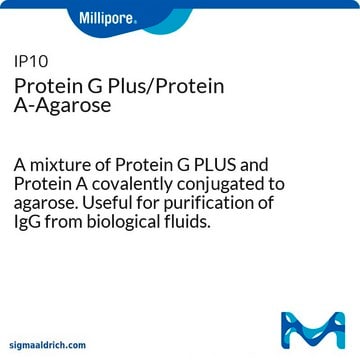P6649
Protein A–Sepharose™ 6MB
aqueous ethanol suspension
Synonym(s):
Protein A–Agarose macrobeads
Sign Into View Organizational & Contract Pricing
All Photos(1)
About This Item
Recommended Products
form
aqueous ethanol suspension
extent of labeling
~1 mg per mL
matrix activation
cyanogen bromide
matrix attachment
amino
matrix spacer
1 atom
capacity
~6 mg/mL binding capacity (human IgG)
storage temp.
2-8°C
Looking for similar products? Visit Product Comparison Guide
General description
P6649-10ml′s updated product number is GE17-0469-01
Application
Protein A-Sepharose™ is used for affinity chromatography, antibody purification and characterization, immunoaffinity matrices, protein chromatography, protein A, G and L resins, and recombinant protein expression and analysis. Protein A-Sepharose™ has been used to develop strategies for investigating protein interactions, to improve the detection of celiac disease, and to study diabetes in children.
Protein A–Sepharose™ 6MB has been used in immunoprecipitation.
Physical form
Suspension in 20% ethanol
Legal Information
Sepharose is a trademark of Cytiva
Signal Word
Warning
Hazard Statements
Precautionary Statements
Hazard Classifications
Flam. Liq. 3
Storage Class Code
3 - Flammable liquids
WGK
WGK 3
Flash Point(F)
100.4 °F
Flash Point(C)
38 °C
Certificates of Analysis (COA)
Search for Certificates of Analysis (COA) by entering the products Lot/Batch Number. Lot and Batch Numbers can be found on a product’s label following the words ‘Lot’ or ‘Batch’.
Already Own This Product?
Find documentation for the products that you have recently purchased in the Document Library.
Customers Also Viewed
G V Hillyer et al.
The American journal of tropical medicine and hygiene, 38(3), 547-552 (1988-05-01)
Total RNA containing messenger RNA has been isolated from adult Fasciola hepatica and translated in vitro using the rabbit reticulocyte lysate system. L-[35S]-methionine labeled translation products have been immunoprecipitated with sera collected from rabbits infected with F. hepatica, rabbits immunized
Nikolai Peschek et al.
The EMBO journal, 38(16), e101650-e101650 (2019-07-18)
Small regulatory RNAs (sRNAs) are crucial components of many stress response systems. The envelope stress response (ESR) of Gram-negative bacteria is a paradigm for sRNA-mediated stress management and involves, among other factors, the alternative sigma factor E (σE ) and
Gaurav Dugar et al.
Molecular cell, 69(5), 893-905 (2018-03-03)
Cas9 nucleases naturally utilize CRISPR RNAs (crRNAs) to silence foreign double-stranded DNA. While recent work has shown that some Cas9 nucleases can also target RNA, RNA recognition has required nuclease modifications or accessory factors. Here, we show that the Campylobacter
Verena Pfeiffer et al.
Molecular microbiology, 66(5), 1174-1191 (2007-11-01)
The Salmonella pathogenicity island (SPI-1) encodes approximately 35 proteins involved in assembly of a type III secretion system (T3SS) which endows Salmonella with the ability to invade eukaryotic cells. We have discovered a novel SPI-1 gene, invR, which expresses an
Aroa Rey Campa et al.
Nucleic acids research, 49(16), 9508-9525 (2021-08-18)
CRISPR-Cas systems provide bacteria with adaptive immunity against phages and plasmids; however, pathways regulating their activity are not well defined. We recently developed a high-throughput genome-wide method (SorTn-seq) and used this to uncover CRISPR-Cas regulators. Here, we demonstrate that the
Our team of scientists has experience in all areas of research including Life Science, Material Science, Chemical Synthesis, Chromatography, Analytical and many others.
Contact Technical Service












